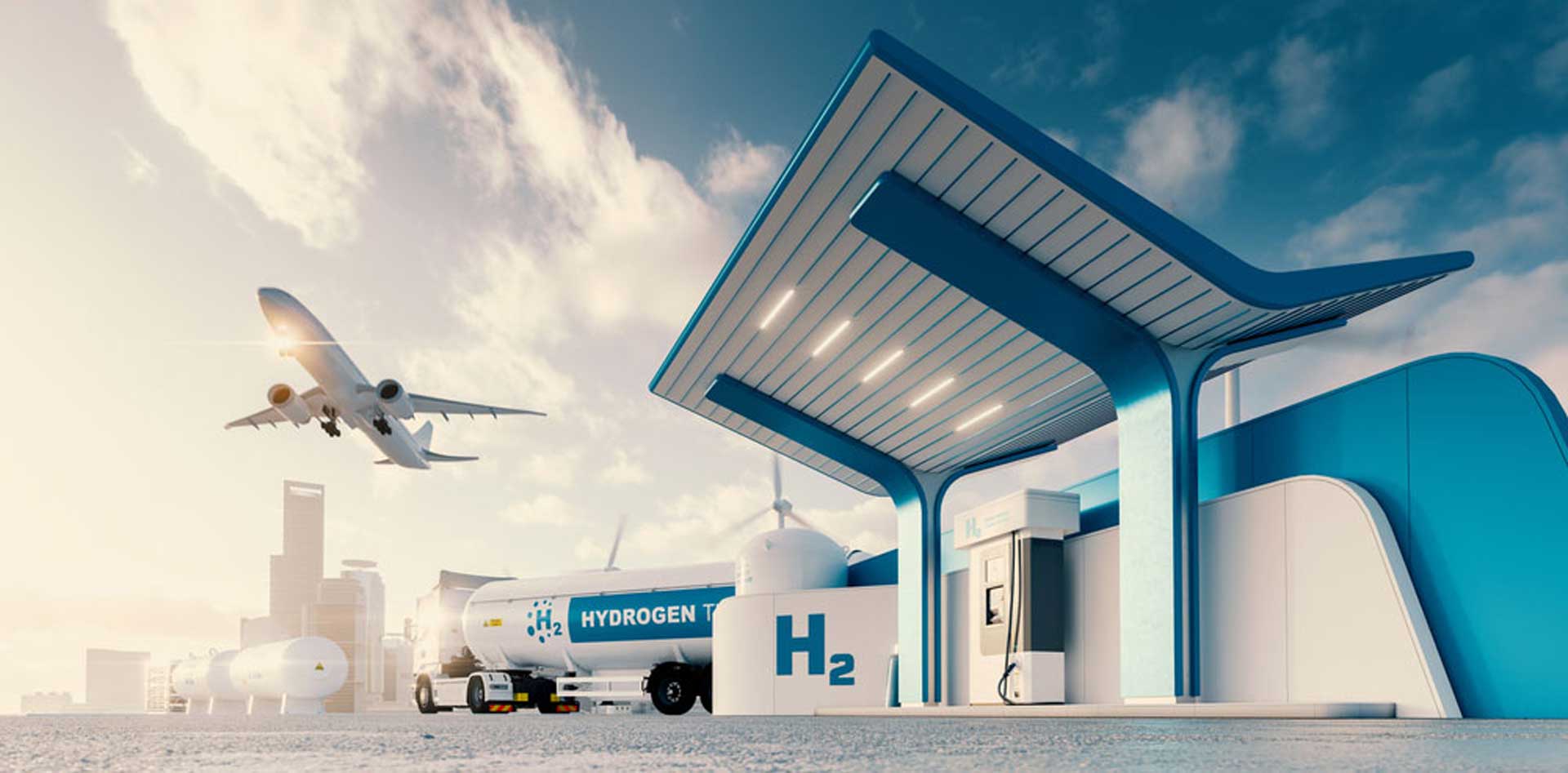- Olga Schmidt
- 12.12.25
- 2 min
- Success factor sustainability
Unleashing the future: liquid hydrogen as a clean energy solution
- Dr Günter Hohmann
- 07-03-2024
- 4 min
The demand for clean energy solutions has never been greater. One of the most promising candidates in this area is cryogenic hydrogen - hydrogen that is cooled to extremely low temperatures so that it can be stored in a liquid state.
Liquid hydrogen as an energy carrier means a revolution in energy production and in the way we will store and use energy in the future. We want to drive this revolution forward. The international innovation network "KryoH2", which is currently being planned, aims to bring together players from the field of cryogenic hydrogen in order to jointly develop practicable solutions in a wide range of areas. It is funded by the Central Innovation Program for SMEs (ZIM).
What makes liquid hydrogen so special?
Green hydrogen can be produced in a climate-friendly way using renewable energy sources: Carbon emissions are significantly reduced. Hydrogen also offers a wide range of potential applications in fuel cells, as a fuel for the aerospace and automotive industries and in large-scale energy storage. In liquid form, hydrogen is at the forefront of energy innovation for several reasons.
High energy density
Liquid hydrogen offers a higher energy density compared to other storage methods. This makes it a superior choice for various applications, from transportation to power generation.
Efficient transportation
In liquid form, hydrogen can be transported in larger quantities over longer distances. This is particularly relevant for supplying infrastructure that is far away from H2 production sites.
Storage
Liquid hydrogen is suitable for space-saving storage in insulated tank systems. This helps to compensate for seasonal fluctuations in energy generation from renewable sources such as wind and solar.
What are the challenges of using liquid hydrogen?
The use of liquid hydrogen offers enormous potential, but it also brings with it some significant challenges that need to be overcome.
Cryogenic storage requirements
One of the main challenges of liquid hydrogen is the need for cryogenic storage. Maintaining temperatures below -252.87°C requires specialized equipment that can be expensive and energy intensive. This requirement presents a logistical challenge for widespread adoption.
Energy-intensive production
The process of liquefying hydrogen is energy intensive and involves several stages of cooling and compression. It is important to ensure that the energy used for liquefaction comes from renewable sources in order to maintain the overall positive environmental impact of liquid hydrogen.
Safety concerns
Hydrogen is highly flammable and its storage and handling require strict safety measures. Although liquid hydrogen is generally safe when properly managed, the risk of leaks and explosions requires careful design and operation of storage and transportation systems.
Where can cryogenic hydrogen be used?
Liquid hydrogen is far more than just a theoretical concept; it is a practical and forward-looking solution. Despite existing challenges, the future of liquid hydrogen looks promising. Technological innovations and infrastructure development are gradually overcoming the current obstacles and making liquid hydrogen an increasingly viable energy solution. Here are some key areas where liquid hydrogen is playing or is expected to play a significant role:
Mobility
Aerospace
Cryogenic hydrogen is used as a rocket fuel due to its high energy density and clean-burning properties. Both NASA and ESA have been using liquid hydrogen in their space missions for decades.
Heavy goods traffic
Hydrogen fuel cells can be used in vehicles, offering an emission-free alternative to conventional gasoline engines. Liquid hydrogen can be used in these fuel cells and offers longer ranges and faster refueling times. Heavy goods vehicles and trucks in particular offer optimal use of the advantages of liquid hydrogen.
Railroads and trains
The rail industry is researching liquid hydrogen as a clean energy source for trains. Hydrogen-powered trains, such as those being developed and tested in Europe, can replace diesel locomotives, reduce emissions and improve air quality. Liquid hydrogen offers high energy density, which is crucial for long-distance travel.
Shipping
The shipping industry is researching the use of cryogenic hydrogen as a fuel for ships in order to reduce the environmental impact of maritime transportation.
Heating in residential and commercial buildings
Hydrogen can be used in heating systems for residential and commercial buildings and offers a clean alternative to natural gas and other fossil fuels.
Power generation and grid stability
Integration of renewable energies
Hydrogen can play a key role in integrating renewable energy sources into the grid by storing and releasing surplus energy when demand is high.
Emergency power supply
Liquid hydrogen can be used as an emergency power source for critical infrastructure to ensure reliability and continuity of services during power outages.

Why a network that deals with liquid hydrogen?
The planned ZIM network "KryoH2" aims to bring together a diverse group of partners from science, industry and research institutions. Our aim is to promote collaboration and innovation in the field of cryogenic hydrogen. By joining forces, we can overcome technical challenges, advance science and accelerate the commercialization of this breakthrough technology.
What are the goals of the "KryoH2" innovation network?
The ZIM-funded "KryoH2" network has set itself ambitious goals to advance the development and application of liquid hydrogen:
Joint research projects
By pooling resources and expertise, network participants will work on advanced and potentially funded research projects that address key challenges of cryogenic hydrogen technology.
Promotion of exchange
Regular workshops, seminars and network meetings will be organized to promote the exchange of ideas, research results and best practices among network participants.
Technological advances
Through joint efforts, we aim to push the boundaries of current technology and develop more efficient, safer and cost-effective solutions for the storage and use of cryogenic hydrogen.
Why join the international hydrogen network?
Joining the KryoH2 innovation network offers a variety of benefits and opportunities to advance the development and application of liquid hydrogen:
Access to expertise
Collaborate with leading experts in the field of cryogenic hydrogen and gain insights into their research and experience.
Funding opportunities
Increase your chances of securing research and development funding through a strong, unified network and the support of EurA AG.
Innovation Center
Become part of an innovation ecosystem that fosters creativity, problem solving and technological breakthroughs.
Networking
Connect with industry leaders, researchers and decision makers who are shaping the future of energy.
Would you like more infomation?
We are actively looking for partners who share our vision of a sustainable future through cryogenic hydrogen. Whether you are a research organization or a company, your participation is invaluable. By joining the "KryoH2" innovation network, you have the opportunity to be at the forefront of this transformative technology. Together, let's unleash the full potential of cryogenic hydrogen, drive innovation, research and development. Your expertise, ideas and commitment are the key to a greener future.
For more information, please contact our hydrogen experts. Together, we can make significant progress towards a cleaner, more efficient energy landscape.
Text: Dr. Denis Öhl

Your contact person
Dr Günter Hohmann
Do you want to learn more about this topic? Schedule a meeting with an expert.
Related articles
- Olga Schmidt
- 27.11.25
- 3 min
- Success factor sustainability
- Bogdana Vatashka
- 26.11.25
- 1 min
- Funding advice, For SME, For research
- Levin Winzinger
- 19.11.25
- 3 min
- Recycling, Success factor sustainability
- Dr Thomas Kraus
- 18.11.25
- 3 min
- EIC Accelerator, EU funding programmes
- Julian Seethaler
- 10.11.25
- 1 min
- For SME, EU funding programmes, For start-ups,

.jpeg)







EurA AG
T- 079619256-0Max-Eyth-Straße 2
73479 Ellwangen
info@eura-ag.com